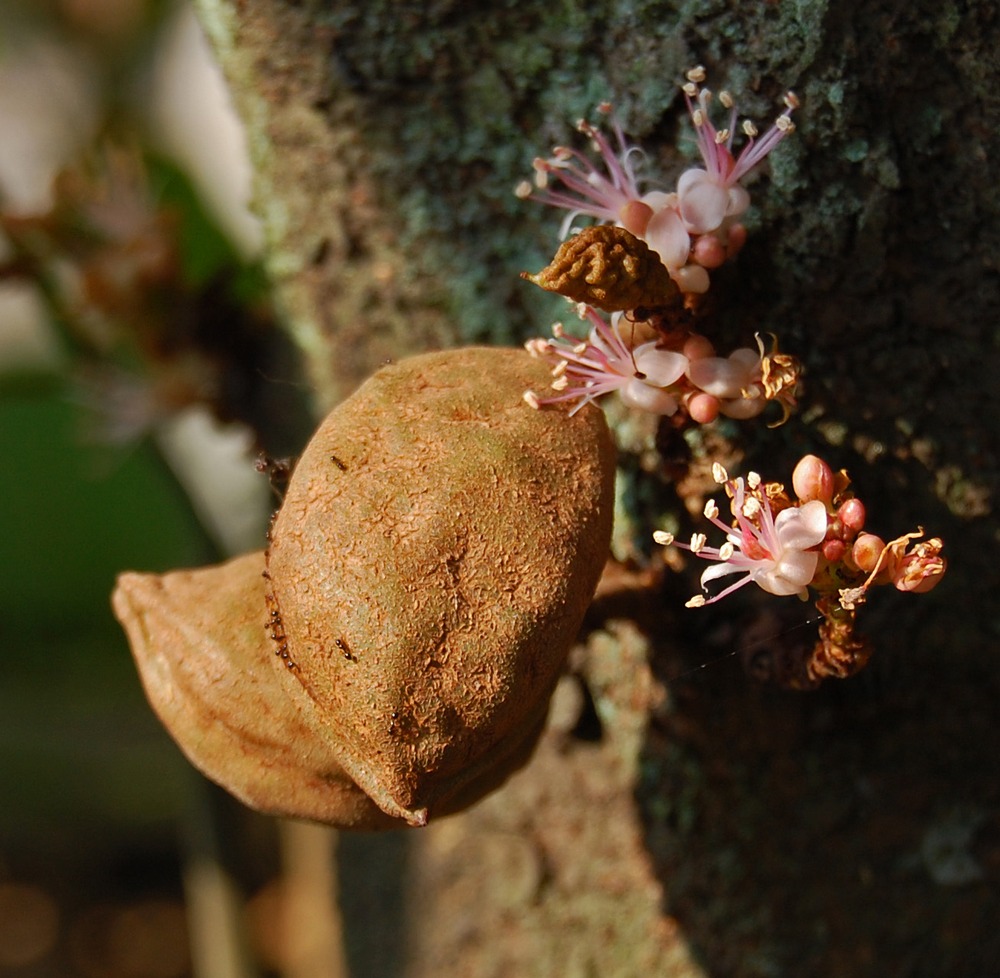Description
Nam Nam fruit grows on the tree Cynometra cauliflora, which is characterized by its cauliflorous flowers that emerge directly from the trunk and branches. This unique growth habit allows the fruit to develop in clusters along the stems. The fruits brownish-green kidney-shaped fleshy pods, 3-9 cm long, containing 1 brown flattened seed. The pod does not split open readily, but a line is visible along the fruit and divides it into two. The texture of the skin is coriaceous and uneven. The pod is edible, with aromatic and juicy yellow pulp.
In Sri Lanka, it is primarily known as Namnam and is found in home gardens and some commercial plantations, particularly in the wet and intermediate zones. The tree is wind-resistant.
Planting requirements
Planting season: October to November
Planting conditions:
| Propagation | Direct seeding or through budding |
|---|---|
| Planting method | Well-draining soil is ideal |
| Soil | Prefers a pH in the range 5-6, tolerating 4.5-6.5. Avoid waterlogging, especially during monsoon seasons. Ensure proper drainage |
| Water | Moderate water requirements. Annual rainfall of 1,500-2,000mm preferred, tolerates 1,200-2,500mm. |
| Sunlight | Full sun preferred, but tolerates some shade |
Growing conditions:
| Temperatures | Prefers annual daytime temperatures within the range 22-35°C, but can tolerate 17-40°C. May require protection from extreme heat in dry zones |
|---|---|
| Elevation | Grows well at elevations up to 400 meters |
| Soil | Well-draining soil is ideal |
| Water | Regular watering during dry periods, especially in dry and intermediate zones |
| Pruning | Prune to encourage bushier growth |
| Weed control | Mulch around the base of the plant to suppress weeds and retain moisture |
Harvesting
Seedling trees begin to flower after about 6 years. Pods mature about 2 months after flowering. Fruits are ready to harvest when they turn yellow-brown.
Curing
The fruits can be eaten fresh or dried for later use.
Storage
Store fresh fruits in a cool, dry place for up to a week. For longer storage, dry the pods and keep them in an airtight container in a cool, dry place for up to 6 months.
Protecting your plants
Pest control
Pest type: Mealybugs
Symptoms: White, cottony masses on stems and leaves, stunted growth.
Control method: Use neem oil or introduce natural predators like ladybugs. Prune affected parts if infestation is severe.
Disease Control
Disease type: Root rot
Symptoms: Yellowing leaves, wilting, stunted growth, and eventual plant death.
Management: Ensure well-draining soil, avoid overwatering, and improve soil aeration. Remove affected plants to prevent spread.
Sources
In addition to our General List of Sources (link), we used these specific references:
- https://doa-gov-lk.translate.goog/fruit-crops-namnam-s/
- https://www.nparks.gov.sg/florafaunaweb/flora/2/8/2833
- Samling, B. A., Assim, Z., Tong, W. Y., Leong, C. R., Ab Rashid, S., Kamal, N. N. S. N. M., … & Tan, W. N. (2021). Cynometra cauliflora L.: An indigenous tropical fruit tree in Malaysia bearing essential oils and their biological activities. Arabian Journal of Chemistry, 14(9), 103302.
- https://tropical.theferns.info/viewtropical.php?id=Cynometra+cauliflora
- https://tropicalfruitfarm.com.my/fruits/k-o,n/nam-nam/
